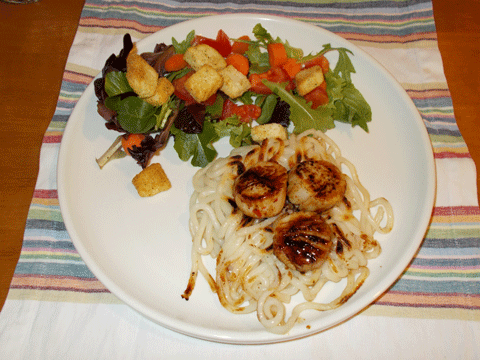 The finished product! |
A couple years back, I decided I wanted a new challenge in the kitchen. I love eating scallops at restaurants, and wanted to learn to make them myself. It turns out that home-cooked scallops are crazy-easy, super-delicious, and far cheaper than if you get them when you’re dining out.
But they’re intimidating: How do you get that crispy crust without burning the delicate mollusks? And how do you get them done just medium-rare in the middle, so they’re moist and flavorful, not rubbery and bland?
Recalling a previous year’s cooking lesson from Gordon Ramsay (he taught me how to cook delicious, tender scrambled eggs), I went to the same place I’d found Gordon: YouTube.
It’s truly surprising how much teaching is available on YouTube — and cooking lessons are no exception. I searched for scallops and came up right away with a 2008 video made by Bill King, who was then the executive chef at McCormick and Schmick’s seafood restaurants. (Searching for clams, mussels, oysters, or any other shellfish is similarly rewarding.)
King had a mouthwatering recipe for pan-seared scallops with sweet Thai chili and udon noodles. The video’s production value wasn’t that great, but I wasn’t there for a visual spectacle. The images and audio were clear, the instructions simple and basic, and the demonstration smooth.
I watched it, took notes, and watched it again. Then I went out and bought the ingredients: sweet Thai chili sauce, sesame oil, fresh sea scallops, and a couple packages of precooked udon noodles. (You can also get uncooked ones and make them yourself, just like pasta. I went for the easier option.)
It didn’t cost much; in fact, the scallops, which are so often expensive in restaurants, were under $7 for a solid handful that would serve two. (King’s example included three large scallops; I sometimes opt for four if they’re smaller.) The udon-noodle packets were a dollar apiece. The bottles of chili sauce and the oil were a few dollars each, but they’d keep and be available when I made more scallops later. Sure, it was more expensive than a couple of hamburgers, but not far off the price of steak, and much cheaper than lobster for two (even at today’s sea-bottom prices).
All that remained was to emulate a chef with formal training and decades of experience, in my own kitchen.
It didn’t quite work out the first time. Heeding King’s suggestion to have a very hot skillet, I ended up giving everything a nice layer of carbon. But I was learning, and I could see where I had gone wrong by comparing what happened in my pan with what happened in the video. I knew where I’d gone astray; in fact, I had indeed feared I was burning the noodles and the scallops while they were cooking. I hadn’t jumped in to lower the heat or stop the cooking earlier because I was on my first trial run and taking the directions very seriously.
I would not make that mistake again. It turns out — shocker! — that getting the cooking temperature right is crucial to preparing seafood properly (and, yes, other food too). My pan had been too hot, and I had left the noodles and scallops in the too-hot pan for a bit too long.
Still, I enjoyed the flavors, and was able to craft a plan for improving my performance next time.